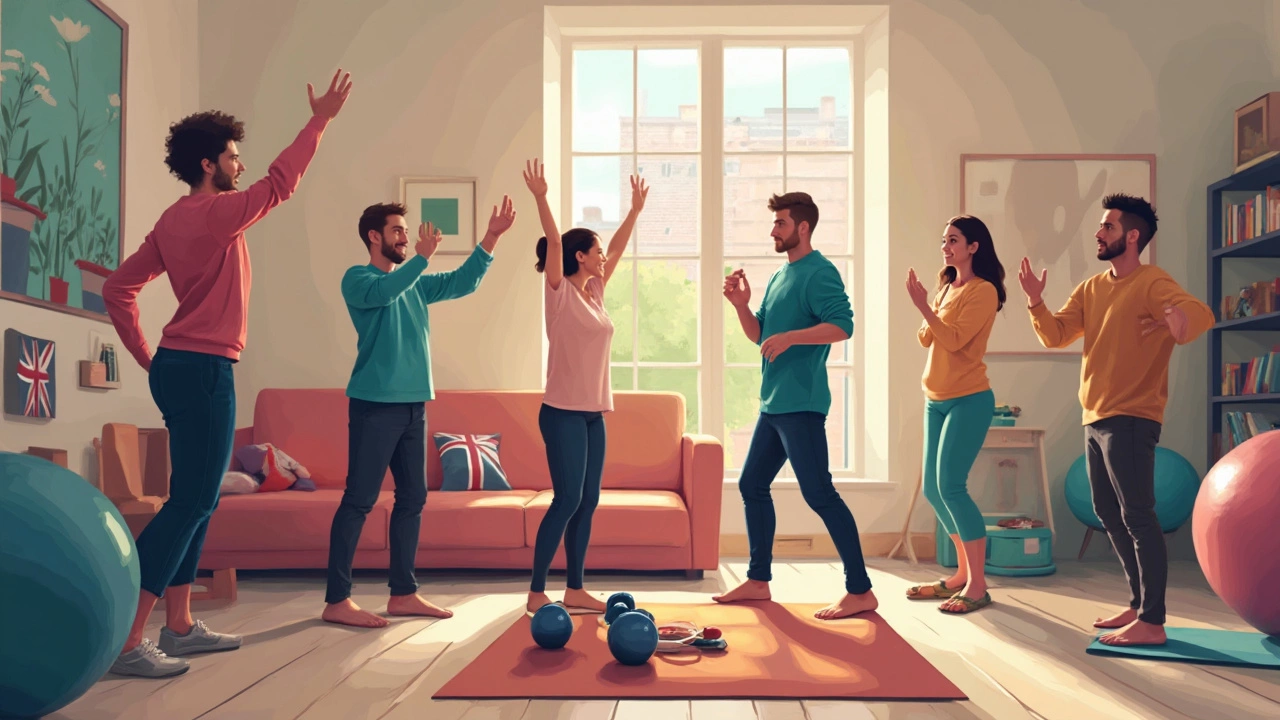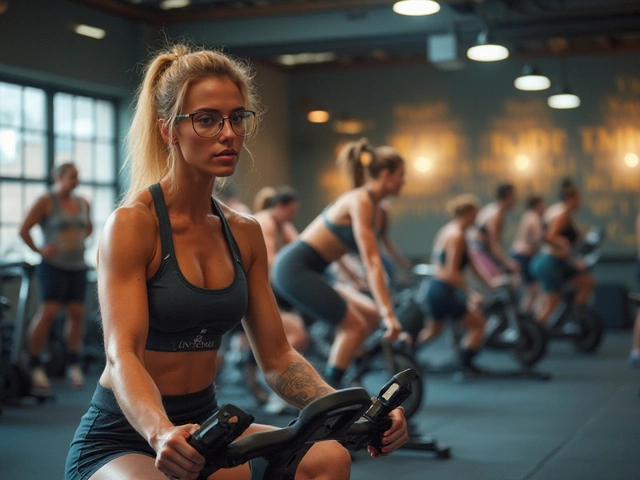The world of home workout gear is a maze. Walk into any store or scroll online, and you’ll find an endless parade of gadgets promising fast results. Here’s the truth: you don’t need most of it, especially when you’re just starting out.
If you’re a beginner, simple is better. You get more out of tools you actually use—like resistance bands or a pair of dumbbells—than fancy machines that collect dust. Those basics cover almost every muscle group, fit in a closet, and don’t break the bank. Plus, you can use them while watching TV. That’s a win.
Jumping right into gear with adjustable options is another smart move. Adjustable dumbbells, for example, save space and let you get stronger without shopping for new stuff every month. And unlike some bulky gym machines, good home equipment fits real-life budgets and busy schedules—especially if you’ve got kids running around, like me.
- Why Choosing the Right Equipment Matters
- Must-Have Equipment for Total Beginners
- What to Skip (and Why)
- Affordable Starter Sets
- How to Build Consistency with Simple Gear
- Tips for Staying Motivated at Home
Why Choosing the Right Equipment Matters
Getting the right start with your gym equipment makes a huge difference for beginners. Buying the wrong stuff doesn’t just waste money—it can seriously hold back your progress and enthusiasm. I’ve seen people grab huge treadmills or machines that need a three-car garage, only to regret it when the novelty wears off and the living room stays cramped.
Let’s get real: the main reasons most people quit working out at home? It feels too hard, it gets boring fast, and equipment takes up too much space. Making smart choices avoids all that. The right equipment makes working out easier, keeps things interesting, and actually fits your home life. Plus, gear you actually use lasts much longer and offers better returns for your money.
- Easy-to-use tools keep you on track—no fancy skills needed to get started.
- Small, portable gear is more likely to get picked up day after day.
- Quality basics cover a ton of exercises, saving you from buying new stuff as your fitness improves.
There’s also safety to think about. Using equipment that matches your fitness level protects you from injury. For example, people are far less likely to drop a resistance band on their foot than a heavy barbell. And adjustable dumbbells let you “level up” safely as you get stronger.
Did you know most beginners use less than half the gear they buy in the first year? It’s true—and here’s a quick look at what actually gets used in home gyms, according to a 2023 survey:
| Equipment | Percentage Used Weekly |
|---|---|
| Resistance Bands | 68% |
| Dumbbells | 62% |
| Yoga Mat | 57% |
| Large Cardio Machines (e.g., Treadmill) | 24% |
| Kettlebells | 20% |
This says a lot: the basics win by a landslide. Choosing smart, versatile equipment means you’re way more likely to use it, get stronger, and actually enjoy the journey. No guilt, no wasted space, and a real shot at building a routine that sticks.
Must-Have Equipment for Total Beginners
Don’t let complicated gym setups fool you—starting with the basics makes things way easier. Here’s what you actually need if you’re a beginner wanting real results with the least hassle. Each piece knocks out multiple exercises for your home routine, which is key, especially if you’re tight on space or money.
- Gym equipment pick #1: Resistance bands. They’re brilliant for every fitness level, cost less than a takeout pizza, and don’t need any assembly. Use them for squats, rows, glute bridges, and even stretching. They also travel easily, so vacations or kid playdates won’t derail your plans.
- Dumbbells (adjustable or a light pair). Go for 5-10 lbs to start. You’ll use them for everything—curls, overhead presses, chest work, you name it. The average woman can see strength improvements in just a few weeks with regular dumbbell use, according to ACE (American Council on Exercise).
- A sturdy yoga or exercise mat. Not just for yoga, but for floor workouts, Pilates, or basic stretching. It means no sore knees on the tiles or carpet burns from planks.
- Optional but super handy: a foam roller. Post-workout, this helps loosen tight muscles and keeps injuries at bay. Even my daughter Cassia uses it when her legs get achy after soccer practice.
Here’s the main thing: you don’t need that big treadmill or rowing machine up front. You can get a full-body workout with these basics without turning your living room into a gym showroom. Stick with the essentials while you find your groove, and you’ll avoid buyer’s regret and wasted cash.
What to Skip (and Why)
If you’re just getting into home workouts, there’s honestly a ton of equipment you can skip—no matter what flashy ads tell you. You’ll save money and avoid turning your living room into a graveyard of unused gear.
Here’s what beginners should usually say “no thanks” to:
- Big cardio machines like treadmills, ellipticals, or fancy bikes. They’re expensive, eat up space, and you can get similar results from bodyweight or simple movements—think brisk walks, jumping jacks, or stairs (yes, just climb your own stairs!)
- Those ab machines or twister gadgets. They promise six-pack abs but don’t actually target your muscles better than standard planks or crunches.
- All-in-one “home gym” stations. These bulky setups cost thousands and aren’t beginner-friendly. The setups take up a ton of room and end up complicated for most people who just want to move, not assemble battle robots.
- Vibration platforms or “miracle” tools. Advertisers hype them like crazy, but studies from the American Council on Exercise (ACE) keep showing regular strength and cardio routines work way better for actual results.
Here’s a quick breakdown comparing costs and stats for what people think they need vs. what works:
| Equipment | Average Cost | Estimated Calories Burned (30 min) | Space Needed |
|---|---|---|---|
| Treadmill | $700+ | 200-400 | Large |
| Resistance Bands | $10-$30 | 150-250 | Minimal |
| Ab Machine | $100-$200 | 50-100 | Medium |
| Dumbbells | $30-$70 | 150-300 | Minimal |
You really get the best bang for your buck sticking with basic, versatile tools instead of splurging on one-trick ponies. Ask yourself: Will I actually use this, or will it end up as another clothes rack? Prioritizing the gym equipment that gives you true results (not just empty promises) means you’ll stay consistent—and actually enjoy the process.

Affordable Starter Sets
You don’t need to drop hundreds of dollars to set up a beginner-friendly home gym. Some of the best gym equipment for beginners is simple, cheap, and easy to find. I’ve tested tons of gear over the years, and here’s what actually gives you the most value without blowing your budget.
Most fitness trainers recommend starting with three basics: resistance bands, a pair of light to medium dumbbells, and a quality exercise mat. With these, you can do squats, presses, rows, core work—pretty much everything you need to build strength and get moving.
- Resistance bands: These cost around $10–$20 for a set. They’re super portable and cover everything from warmups to stretching to strength training.
- Dumbbells (adjustable or fixed): You can find adjustable dumbbells starting near $50 a pair. Fixed dumbbells may be even cheaper if you buy used. Start with 5–10 lb weights and move up as you get stronger.
- Exercise mat: For floor work and stretches, a non-slip mat makes all the difference. Decent mats run about $20–$30. Look for at least half-an-inch thick foam for comfort.
Here’s what a typical starter kit looks like, based on average online and in-store prices as of early 2025:
| Item | Average Price (USD) |
|---|---|
| Resistance Bands (Set) | $15 |
| Dumbbells (Pair, Adjustable) | $50 |
| Exercise Mat | $25 |
| Total | $90 |
Don’t overlook bodyweight options, either. Apps and YouTube channels (like HASfit or Fitness Blender) use these basics in all kinds of beginner routines. Some starter sets even come with quick-start workout guides, which is a bonus when motivation dips.
You can usually find these kits online, at big box stores, or second-hand. Just check the reviews for quality—cheap doesn’t mean flimsy. If you want to add a little more, a jump rope or a kettlebell is a small step up without blowing your budget.
How to Build Consistency with Simple Gear
Getting into a routine with home workouts is half the battle. The right gear can make things so much easier by removing excuses and giving you the tools you really need. Picking gym equipment that’s easy to set up and put away means you’re more likely to stick with your workouts.
Start by keeping your gear visible and within reach. For example, a set of resistance bands or dumbbells right by your TV can remind you to squeeze in a few sets during your favorite shows. If you have to dig gear out from under the bed or out of the garage every time, chances are you’ll skip it. Simplicity helps you stick with it.
- Set a specific schedule: Short, regular sessions (like 20–30 minutes, 3–4 times per week) beat long, rare workouts. Write your workouts on a calendar or set phone reminders.
- Make your space inviting: Don’t overthink it. Just a yoga mat on the floor is enough. Natural light helps. If you have kids, make it a family thing—Cassia sometimes does floor stretches with me, which keeps it fun and less lonely.
- Follow ready-made routines: There are tons of beginner videos using just bands or dumbbells. Having a set routine removes the stress of planning and helps you build a habit.
- Track your progress: Whether it’s reps, weight, or just hitting your weekly goal, tracking keeps you motivated. Some people use old-school paper charts, others use free phone apps.
Here’s something wild: A study by the Physical Activity Council found that over 60% of people who set up a dedicated home workout space (even just a corner) ended up sticking to their routine for at least 6 months. Compare that to the 27% who never made a specific space or plan for their home workouts. Having a go-to spot really does help.
| Gear | Avg. Cost (USD) | Avg. Space Needed | Typical Usage (per week) |
|---|---|---|---|
| Dumbbells (Adjustable) | $50–$100 | 2 ft x 2 ft | 3–4 sessions |
| Resistance Bands | $15–$30 | Tiny (drawer) | 3–5 sessions |
| Yoga Mat | $10–$30 | 3 ft x 6 ft | Daily to 3 times |
Bottom line: The easier you can set up and use your gear, the more likely you are to keep moving. Baby steps add up fast—consistency beats intensity every time, especially at the start. Build the habit, and the results come naturally.
Tips for Staying Motivated at Home
Getting started with home workouts is one thing—sticking with them is the real challenge. Some days, motivation vanishes, especially after a long workday or dealing with family chaos. But there are practical ways to keep yourself going. Here’s how I’ve made it work, even with my daughter Cassia poking her head into my squats.
- Set micro-goals: Instead of telling yourself you need to "get fit," aim for something simple, like finishing three beginner workouts this week. Hitting easy targets builds momentum.
- Schedule workouts like appointments. If it’s in your calendar, it’s way harder to skip.
- Keep your gym equipment out in plain sight—a yoga mat rolled out or dumbbells near the couch are way more inviting than stuff tucked away in a closet.
- Track your progress. Use an app or sticky notes—doesn’t matter. Seeing check marks pile up gives a sense of achievement.
- Mix things up with new routines on YouTube or fitness apps. Trying just one new exercise keeps things fresh.
- Pair your workout with something enjoyable—maybe your favorite music or that binge-worthy show you’re finally watching.
- Ask a friend or partner to join. Virtual buddy systems or sharing updates in a group chat can boost commitment.
If you like seeing data, here’s a little dose of reality. Studies consistently show that people who track their progress and have social support are nearly twice as likely to stick to home workouts:
| Habit | Chance of Sticking to Workouts (6 Months) |
|---|---|
| Tracking Progress | 68% |
| Social Support | 71% |
| No Tracking/Support | 37% |
And don’t beat yourself up if you miss a day. The average person skips about six workouts per month and still stays on track, according to a 2022 fitness industry summary. Consistency over time matters more than chasing perfection. Progress is progress, even on slow days.





